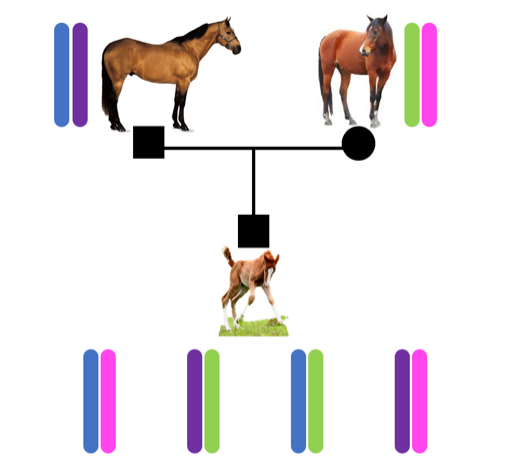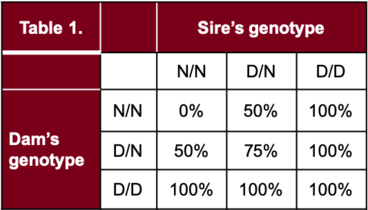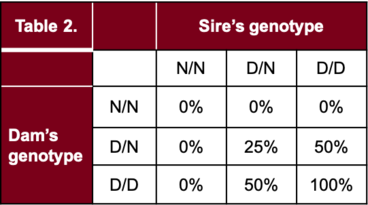
There are approximately 22,000 genes in the equine genome. Each horse has two copies of every chromosome and every gene, one inherited from the dam and one from the sire (Figure 1). Each copy of a gene may not have the identical DNA sequence of base pairs. Alternate DNA sequences of the same gene are called alleles. A horse can sometime inherit the same allele from each parent, making it homozygous for that allele. Or, a horse can inherit different alleles from each parent, making it heterozygous. A horse’s combination of alleles is known as its genotype.
An allele that causes a Mendelian disease or trait is often referred to as a genetic mutation, and the location of this mutation in the genome is often referred to as a disease locus. At a disease locus, a horse inherits either a normal form (allele) of the gene or a mutant form (allele) of the gene from each parent. Here we have designated the letter D to indicate the mutant, disease-causing alleleof the gene, and N to indicate the normal allele of the gene. A homozygous normal horse is designated as N/N. Horses can also be heterozygous D/N or homozygous D/D for the mutation.
In an autosomal recessive disease, a horse must have 2 copies of the mutant allele to have disease; in other words, the disease only occurs in horses that are homozygous affected (D/D). Horses that are heterozygous (D/N) do not have the disease. In a recessive disease, heterozygous horses are often referred to as “carriers” because even though the horse itself does not have disease, it can pass the disease allele on to its offspring and, depending on the horse the carrier is mated to, it can produce affected offspring (see single gene disease transmission below).
In an autosomal dominant disease, only one copy of the mutant allele is needed to cause disease; in other words, the disease occurs in horses that are heterozygous affected (D/N) or homozygous affected (D/D). Only horses that are homozygous normal (N/N) do not have disease. The term “carrier” does not apply in a dominant disease because heterozygous horses (D/N) have disease.
Single gene diseases can also be inherited in a sex-linked, co-dominant or incomplete dominant manner.

With single gene diseases the likelihood of the disease being transmitted from parent to offspring can be predicted using a Punnett square based on the genotype of each parent. Using the Punnett square the chance of an affected offspring for a dominant disease based on all possible sire and dam genotype combinations is summarized in Table 1. In the case of a dominant trait, the only sire/dam genotype combination that does not have a risk of producing an affected foal is if both parents are N/N.

Using the Punnett square the chance of an affected offspring for a recessive disease based on all possible sire and dam genotype combinations is summarized in Table 2. In the case of a recessive trait, the only sire / dam genotype combinations that have a risk of producing an affected foal is if both parents are D/D or N/D.